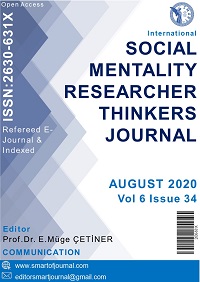1990 SONRASI TÜRK SİNEMASINDA ŞİDDETİN VE ŞİDDET ESTETİĞİNİN KÜLTÜREL KÖKENLERİ; EŞKIYA FİLMİ ÖRNEĞİ
Author :
Abstract
Şiddet gündelik hayatta toplumsal ilişkileri kuran ve bozan, yapıcı ve yıkıcı bir olgudur. Antropologlarca yapılan çalışmalardan çıkan sonuca göre şiddetten ne anlaşıldığı kültürden kültüre değişmektedir. O halde şiddetin ne anlama geldiği, neyin şiddet neyin şiddet olmadığı kültürel referanslara bağlı olmaktadır. Burada belirleyici olan Türkiye toplumunda ve Sinemasında hangi kültürel yapının şiddeti anlamlandırdığı ve şiddete neden olduğudur. Bu bağlamda ağırlıklı olarak Armağan kültürü öne çıkmaktadır.1990’ lı yıllardan günümüze Türk Sinemasında şiddetin gerek içerik gerekse biçim ile olan ilişkisinde Armağan kültürü ile karşılaşılmaktadır. İçerik bağlamında 1990 sonrası Türk Sinemasında şiddetin nedeni olarak Armağan kültürü ile bağlantılı itibar, prestij, statü, onur, rekabet, kıskançlık, meydan okuma, utanç, küçük düşme ve aşağılanma korkuları görülmektedir. Biçim bağlamında ise şiddet yine Armağan kültürü ile bağlantılı, bedenlerin ve nesnelerin abartılı imhasına dayalı olarak temsil edilmektedir.
Keywords
Abstract
Violence is a constructive and destructive phenomenon that creates and disrupts social relations in everyday life. According to the results of studies done by anthropologists, what we understand from violence varies from culture to culture that is directly related to it. Decisive here, Cinema and society in Turkey which cultural structure it makes sense of violence and cause violence. In this context predominantly the gifts culture stand out. From the 1990’s to the present day in Turkish Cinema, In the relation of violence with content and form, it is encountered with gift culture. In the context of content, the fears of prestige, status, honor, competition, jealousy, challenge, shame, humiliation and humiliation associated with the gift culture are seen as the cause of violence in Turkish cinema after 1990. In the context of form, violence is again associated with the gift of culture, based on the exaggerated destruction of bodies and objects
Keywords
- Adanır, O. (2010). Eski Dünyaya Yeni Bir Bakış, Ankara, Doğu Batı Yayınları. Brookman, F. (2005). Understanding Homicide, London, Sage Publications
- Bruni, L. Zamagni, S. (2013). Handbook on the Economics of Reciprocity and Social Enterprise, Cheltenham, Edward Elgar Publishing
- Burke, P. (2008). Kültür Tarihi, (çev. Mete Tunçay), İstanbul, İstanbul Bilgi Üniversitesi Yayınları. Cowell, A. (2007). The Medieval Warrior Aristocracy, Cambridge, D.S. Brewer
- Coyne, R. (2005), Design and Dissent on the Internet, Cambridge, The Mit Press,
- Crapo, R. (1996). Cultural Anthropology: Understanding Ourselves And Others. Madison, WI: Brown and Benchmark
- Elsaesser, T. (2004),The Last Great American Picture Show: New Hollywood Cinema in the 1970s, Amsterdam, Amsterdam University Press
- Eriksen, T.H. (2004). What is Anthropology? London, Pluto Press
- Field, S. (2013). Senaryo, (çev. Şerif Erol), İstanbul, Alfa Yayınları. MİLLER, William Ian (1996). Bloodtaking and Peacemaking, Chicago, The University of Chicago Press.
- Gianetti, L. (2008). Understanding Movies, New Jersey, Pearson Prentice Hall.
- Guynn, N. D. Stahuljak, Z. (2013). Violence and the Writing of History in the Medieval Francophone World, Cambridge, Gallica Press.
- Hearn, J. (1998). The Violence of Men, London, Sage Publications
- Huizinga, J. (1997). Ortaçağın Günbatımı, (çev. Mehmet Ali Kılıçbay), Ankara, İmge Yayınları, Kolker, R.(2011). Film, Biçim ve Kültür, (çev. Ertan Yılmaz), Ankara, Deki Yayınları.
- Kupfer, J. (1983), Experience as Art: Aesthetics in Everyday Life, Albany, State University of New York Press,
- Levy-Bruhl, L. (2006). İlkel Toplumda Mistik Deneyim ve Simgeler, (çev. Oğuz Adanır), Ankara, Doğu Batı Yayınları
- Mauss, M. (2011). Sosyoloji ve Antropoloji, (çev. Özcan Doğan), Ankara, Doğu Batı Yayınları.
- Muchembled, R. (1998). İşkenceler Zamanı, (çev. Ali Berktay), İstanbul, Tüm Zamanlar Yayınları Prince, S. (2000). Screening Violence, New Jersey, Rutgers University Press,
- R.Ruff, J. (2011). Erken Modern Dönem Avrupa’ da Şiddet, (çev. Didem Türkoğlu), İstanbul, Boğaziçi Üniversitesi Yayınları.
- Riches, D. (1989). Antropolojik Açıdan Şiddet, (çev. Dilek Hattatoğlu), İstanbul, Ayrıntı Yayınları. Ryan, M. Kellner, D. (2010). Politik Kamera, (çev. Elif Özsayar), İstanbul, Ayrıntı Yayınları.
- Schinkel W. (2010). Aspects of Violence, New York, Palgrave-Macmillan.
- Scott, G.R (2001). İşkencenin Tarihi, (çev. Hamide Koyukan), Ankara, Dost Yayınları. Slocum, J. D. (2001). Violence and American Cinema, New York, Routledge
- Sweet, L. (1999), Soultsunami: Sink or Swim in New Millennium Culture, Zondervan, Michigan
- Wayne, M. (2011). Politik Film: Üçüncü Sinemanın Diyalektiği, (çev. Ertan Yılmaz), İstanbul, Yordam Kitap
- Arda, E. ( 2003). Sosyal Bilimler El Sözlüğü, İstanbul, Alfa Yayınları.Clari, M. ( 2004). Collins Cobuild, Glasgow, Harper Collins Publishers
- Fowler H. W (1964). The Concise Oxford Dictionary, Oxford, Oxford University Press.
- Lorimer, T. L. (1996). The New Webster’s Dictionary, New York, Lexicon Publications.Murray, James A.H (1970), The Oxford English Dictionary, Oxford, Clarendon Press Stein, J. (1966). Random House Dictionary, New York, New York Publisher.
- Toparlı R. (2009). Türk Dil Kurumu Türkçe Sözlük, Ankara, TDK Yayınları. Dergiler
- Browne, N. (2002). American Film Violence: An Analytic Portrait, Journal of Interpersonal Violence, April 2002, Vol. 17 No. 4, ss. 351-370
- Curta, F. (2006). “Merovingian and Carolingian Gift Giving”, Speculum, Vol. 81, No. 3, ss. 671-Fıske, A.P. (2002). “Using Individualism and Collectivism to Compare Cultures-A Critique of theValidity and Measurement of the Constructs: Comment on Oyserman et al”, Psychological Bulletin, Vol. 128, No. 1, ss.78–88
- Luckenbıll, D. F. (1977). “Criminal Homicide as a Situated Transaction”, Social Problems, Vol. 25, No.2, ss. 176–186





